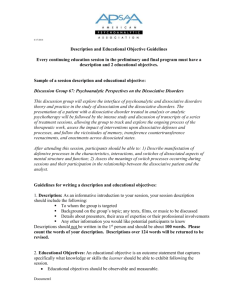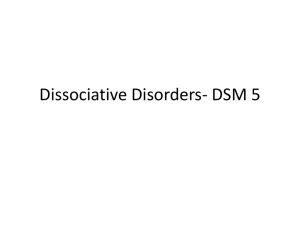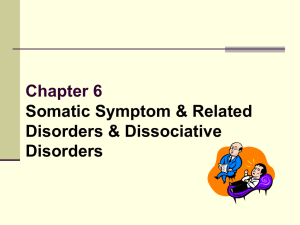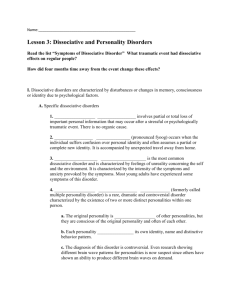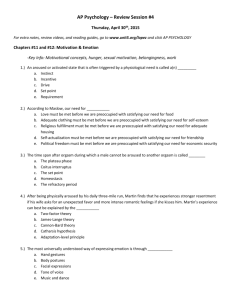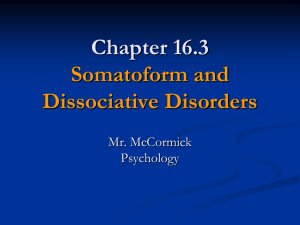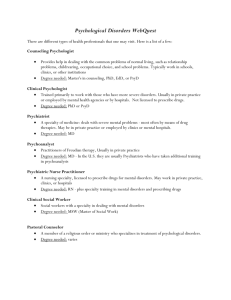disorders in black south africans: a report on five
advertisement
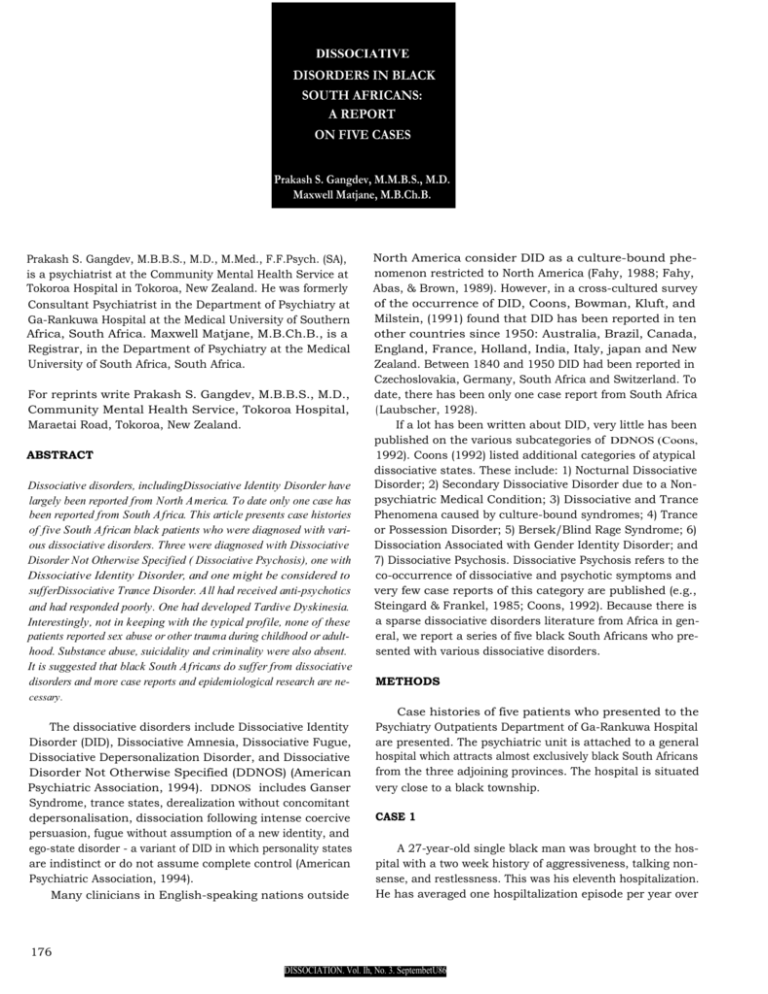
DISSOCIATIVE DISORDERS IN BLACK SOUTH AFRICANS: A REPORT ON FIVE CASES Prakash S. Gangdev, M.M.B.S., M.D. Maxwell Matjane, M.B.Ch.B. Prakash S. Gangdev, M.B.B.S., M.D., M.Med., F.F.Psych. (SA), is a psychiatrist at the Community Mental Health Service at Tokoroa Hospital in Tokoroa, New Zealand. He was formerly Consultant Psychiatrist in the Department of Psychiatry at Ga-Rankuwa Hospital at the Medical University of Southern Africa, South Africa. Maxwell Matjane, M.B.Ch.B., is a Registrar, in the Department of Psychiatry at the Medical University of South Africa, South Africa. For reprints write Prakash S. Gangdev, M.B.B.S., M.D., Community Mental Health Service, Tokoroa Hospital, Maraetai Road, Tokoroa, New Zealand. ABSTRACT Dissociative disorders, includingDissociative Identity Disorder have largely been reported from North America. To date only one case has been reported from South Africa. This article presents case histories of five South African black patients who were diagnosed with various dissociative disorders. Three were diagnosed with Dissociative Disorder Not Otherwise Specified ( Dissociative Psychosis), one with Dissociative Identity Disorder, and one might be considered to sufferDissociative Trance Disorder. All had received anti-psychotics and had responded poorly. One had developed Tardive Dyskinesia. Interestingly, not in keeping with the typical profile, none of these patients reported sex abuse or other trauma during childhood or adulthood. Substance abuse, suicidality and criminality were also absent. It is suggested that black South Africans do suffer from dissociative disorders and more case reports and epidemiological research are ne- North America consider DID as a culture-bound phenomenon restricted to North America (Fahy, 1988; Fahy, Abas, & Brown, 1989). However, in a cross-cultured survey of the occurrence of DID, Coons, Bowman, Kluft, and Milstein, (1991) found that DID has been reported in ten other countries since 1950: Australia, Brazil, Canada, England, France, Holland, India, Italy, japan and New Zealand. Between 1840 and 1950 DID had been reported in Czechoslovakia, Germany, South Africa and Switzerland. To date, there has been only one case report from South Africa ( Laubscher, 1928). If a lot has been written about DID, very little has been published on the various subcategories of DDNOS (Coons, 1992). Coons (1992) listed additional categories of atypical dissociative states. These include: 1) Nocturnal Dissociative Disorder; 2) Secondary Dissociative Disorder due to a Nonpsychiatric Medical Condition; 3) Dissociative and Trance Phenomena caused by culture-bound syndromes; 4) Trance or Possession Disorder; 5) Bersek/Blind Rage Syndrome; 6) Dissociation Associated with Gender Identity Disorder; and 7) Dissociative Psychosis. Dissociative Psychosis refers to the co-occurrence of dissociative and psychotic symptoms and very few case reports of this category are published (e.g., Steingard & Frankel, 1985; Coons, 1992). Because there is a sparse dissociative disorders literature from Africa in general, we report a series of five black South Africans who presented with various dissociative disorders. METHODS cessary. The dissociative disorders include Dissociative Identity Disorder (DID), Dissociative Amnesia, Dissociative Fugue, Dissociative Depersonalization Disorder, and Dissociative Disorder Not Otherwise Specified (DDNOS) (American Psychiatric Association, 1994). DDNOS includes Ganser Syndrome, trance states, derealization without concomitant depersonalisation, dissociation following intense coercive persuasion, fugue without assumption of a new identity, and ego-state disorder - a variant of DID in which personality states are indistinct or do not assume complete control (American Psychiatric Association, 1994). Many clinicians in English-speaking nations outside Case histories of five patients who presented to the Psychiatry Outpatients Department of Ga-Rankuwa Hospital are presented. The psychiatric unit is attached to a general hospital which attracts almost exclusively black South Africans from the three adjoining provinces. The hospital is situated very close to a black township. CASE 1 A 27-year-old single black man was brought to the hospital with a two week history of aggressiveness, talking nonsense, and restlessness. This was his eleventh hospitalization. He has averaged one hospiltalization episode per year over 176 DISSOCIATION. Vol. Ih, No. 3. SeptembetU86 GANGDEV/MATJANE the last decade. At the onset of these episodes he typically complained of a severe headache and sleep disturbance. He then insisted on seeing his father and left home against his mother's wishes. However, he never reached his father. He would be found wandering in the bush where the police would pick him up and escort him to the hospital. The patient was usually unaware of his whereabouts and expressed surprise at finding himself in the hospital. He has received several diagnoses during his previous hospitalizations: schizophrenia, bipolar disorder, schizoaffective disorder, and psychosis. Inter-episodically he is stable, but appears lazy. He seeks the company of his friends, goes to the cinema, and also enjoys watching soccer. He is religious and apolitical. He has had several transient romances, but considers himself not yet ready for marriage. He is a glib salesman. He has had no forensic history. He used to drink alcohol and smoke cannabis, but has been abstinent for a long time. He lives with his mother who is quite contemptuous of his illness. He has no siblings. His parents divorced when he was three years old. Physical examination, blood investigations, electrocephalegram, and SPECT (Single Positron Emission Computerized Tomography) studies were normal. Mental state examination (performed over several sessions) revealed a peculiar speech pattern - incoherent, with seemingly loose associations. At times he insisted on conversing in English and at other times in Afrikaans. He often referred to himself as "eve." He would at times speak in a dramatic manner about the "vulgar fraction" (by which he meant evil spirits), his lack of economic progress, his irresponsible attitude toward his mother, and woman-lumen (womb of an evil woman) coming out of water that can destroy a location (a black or Indian township; i.e., areas where people of a specific race were required to live). He also reported that he heard voices inside his head, but he had learned to control them. Some voices told him to be blasphemous, other convinced him to eat a lot of fruits. He also complained that his mother had bewitched him. He also claimed to be in communication with the environment. He informed that his father was a man of royal descent and he owned 15,000 cows in Venda (then an "Independent Homeland," now a region of southern South Africa). He also heard the voice of God. He never heard voices from outside of his head. When asked if there were any people inside him, he became very agitated. There was no increase in psychomotor activity, though episodically he would become restless and talk loudly in a manner uncharacteristic of him. At times he spoke of the gravitational force, and of negotiations between his parents. There was no cognitive impairment and he generally reported feeling cheerful, and at times agitated. He performed the activities of daily living without any supervision. The diagnosis of schizophrenia does not seem to apply because although the condition started in adolescence and he has been having periodic relapses, inter-episodically he has remained reasonably well. Each episode had a typical onset: headache, wandering and subsequently amnesia. Further, it is extremely unusual to have a profound thought disorder during a psychotic episode and yet have no impairment in activities of daily living. His references to himself as "We " or the traditional company indicate the presence of indistinct ego states. There was no sustained mood disturbance associated with changes in sleep-wake rhythm and appetitive behaviour. Thus the diagnosis of a manic episode is untenable. Also, there was no clinical or laboratory evidence of an organic disorder. As he had concomitant psychotic and dissociative symptoms it was thought that Psychotic Disorder Not Otherwise Specified did not adequately describe the clinical picture. The category of Dissociative Disorder Not Otherwise Specified, while appropriate in many ways, also does not list such a clinical picture among the examples stated in DSMIV. However, Coons' (1992) DDNOS subcategory of Dissociative Psychosis may seem an appropriate description, even though it is not an official diagnosis. Dissociative Fugue (DF) diagnosis, which is suggested by some symptoms, has not been described with concomitant psychosis. CASE 2 A28-year-old, unmarried unemployed black woman was brought to the hospital with a two-week history of speaking incoherently. The symptoms started suddenly when she complained of a severe chest pain. This was her sixth episode of mental illness. The illness began at the age of 12 when she complained of having visions. She was treated by a traditional healer. On recovery she resumed her studies. The second episode occurred in February, 1985, when she began throwing her clothes out of the wardrobe and then became very restless. She became stable a week later but was unable to explain what had happened to her. Subsequently in September, 1985 and April, 1986 she had periods of unspecified behaviour disturbance which lasted a few days. In January, 1989 she was hospitalized because she became apathetic and occasionally irritable. Bronchoscopy and pleural biopsy were performed for unspecified chest pain. The outcome of these investigations is not known. In 1991 she was diagnosed with Takayashu ' s disease. Percutaneous balloon angioplasty was successfully performed. Further, it was reported that the patient also had an episodic tendency to talk and behave like a child for unspecified periods. On recovery, she had complete amnesia for these episodes.There is no known history of any traumatic experiences. The patient is the seventh of nine siblings, five of them dead (causes unknown). The other three are alive and well. She lived with her mother and stepfather. Because she had to give up her studies because of her illness, she helped with household chores. Physical examination and 177 DISSOCIATION, Vol. IX, N. 3, September] 996 DID IN BLACK SOUTH AFRICANS blood investigations were normal. Repeated mental state examinations revealed that she referred to herself in third person and reported that there were people/voices inside " her: Lucifer is trying to control me - makes me do things I ' don t want to do ... There were many others who chain me and when they release me they want me to fight with my parents. My life is in trouble." She also claimed that she had been raped by unidentified black and white men; that an evil and a good spirit were speaking through her. She said that her body actually did not belong to her. She reported that there are bearded people who terrorize her and sleep with her. She believes that these people have infiltrated her, and the spirit of death also troubles her. "They" all take away her mind: "some whites and some blacks - their name is not one, enter inside and sleep with me. They are silly, dead structures. They talk all the time inside me and then I have this chest pain. How can I concentrate and proceed with my life?" She denied hearing voices from outside of her head. There was no mood disturbance or cognitive impairment. The patient had a number of dissociative symptoms which included 1) reference to herself in third person; 2) voices inside her head; 3) the sense of people living inside her; 4) episodes of talking and behaving like a child; and 5) amnesia for these episodes. As she did not assume a new identity or wander away, DID and DF do not seem to be appropriate diagnoses. Her incoherent speech and passivity experience ( " Lucifer is trying to control me and makes me do things I don ' t want to do " ) may be interpreted as features of psychosis, which makes the diagnosis of Dissociative Psychosis, a form of DDNOS, more applicable. CASE 3 A 25-year-old unmarried black man was brought to hospital by his brother, with a five-month history of refusing to eat, occasionally talking to himself, and referring to himself as somebody the family members did not know. His girlfriend had terminated their relationship because he had changed and she could not understand him anymore. The patient seemed neither concerned or distressed about the termination of the relationship. He had no history of drug use or epilepsy. This was his first contact with mental health personnel. During mental status examinations, on several occasions he smiled or laughed inappropriately. He mostly communicated in English and referred to himself as a Mr. Jan van Wyk, 17 years old, and born in Witbank. He mentioned all his family members by name (with the same surname, van Wyk). All this information was not in keeping with the collateral information given by his brother. When confronted with his real identity, he would respond by saying that he is that person, too, but that at present he is Jan van Wyk. He denied hearing voices, and there was no psychomotor or mood disturbance. He was disoriented to time but his cognition was otherwise unimpaired. Physically the patient was underweight. He had a collapsed right lung but was clinically stable. Blood investigations, EEG (electroencephalogram) and SPELT were normal. CT scan showed mild cerebral atrophy. The patient had assumed a new identity. He had also become withdrawn and occasionally talked to himself. Thus the diagnosis of Dissociative Psychosis seems appropriate. DID or DF did not apply because the new identity did not take over executive control of the personality and he did not wander away. The cerebral atrophy reveled on the CT scan was unaccompanied by cognitive impairment. Thus its significance was unexplained. Also there is no evidence that his medical condition had a bearing on his psychological symptoms. CASE 4 A 54-year-old Black male was escorted to the outpatient clinic with a four-month history of aggressiveness. He has been hospitalized several times since 1965. The current hospitalization was probably his eleventh. He had received diagnoses of schizophrenia and mania. Information on his behaviour prior to 1965 is not available. He had held a job till then, but since he became ill he has remained unemployed. He lost his only child and his girlfriend in an accident in 1963 and since then he had remained unattached. He has no forensic or drug history. During the current episode, the patient assumed a different name, at times disappeared, and was unable to recognize his relatives. He felt they were strangers occupying his house and he tries to chase them away. On recovery he had amnesia for this behaviour. Physical examination revealed tardive dyskinesia. Blood investigations were normal. Mental status examination performed over several sessions revealed that the patient identified himself as Clay van Rensburg (not his legal name) and claimed to have been born on September 17, 1889. He also gave incorrect names for his parents, his late girlfriend, and his brothers and sisters. His speech tended to be tangential. Although disabled, he claimed to be holding a job. He did not recognize his brothers and sisters. Although his previous admission had been only a few months before, he had no memory of it and claimed that the current hospitalization was his first. At times he spoke about being the Commissioner of Reginald - of policy collaboration [sic]. He also wanted to go back to school. He denied hallucinations but reported people talking inside him. There was no cognitive impairment. He tended to become irritated easily. On different occasions he identified himself as a teacher, as a station commander in the South African Police and " as a doctor at ' Baragwanath University. He admitted to experiencing five people talking inside his head, but did not wish to elaborate further about this. The diagnosis of DID seemed appropriate as he had 178 DISSOCIATION, Vol. IX, No. 3, Scptcmberl996 GANGDEV/MATJANE TABLE 1 Brief Clinical Profile of the Patients Case 1 27. Male Case 2 28. Female Case3 25. Male Case 4 54. Male Case 5 45. Female Age of onset 17 12 25 20 40 Amnesia + + + + + Ego-states + + + + + + + New identity Depression and mood swings Inner voices + + + Visions + + + - - Childhood sex abuse/trauma No information - No information Adulthood sex abuse/trauma Conversion symptoms Secondary gain Substance abuse Criminality EEG Normal Not performed Normal Not performed Normal SPECT Normal Not performed Normal Not performed Normal CT Scan Normal Not performed Mild cerebral Not performed Normal DID DDNOS-? atrophy Diagnosis Dissociative Dissociative Dissociative Psychosis Psychosis Psychosis. ? Trance states Ego-state disorder assumed several different identities, had reported experiencing five people inside his head, had failed to recognize his relatives, and was unable to recall personal information. These features are not compatible with the diagnosis of schizophrenia or mania. Moreover, he did not have any other psychopathology to suggest the diagnosis of a co-morbid mood or psychotic disorder. CASE 5 A 45-year-old divorced black woman employed as a school teacher presented with a five-or six-year history of episodically "losing time," and distress because of that. Typically she has two or three episodes a year for which she has a complete amnesia. The episodes start suddenly, and last for sev- eral hours. During the episodes her behaviour has never attracted the attention of others and she carries out her assigned tasks; e.g. delivering lectures, shopping, and so forth. Only when an episode is over does she realize that she has no idea how and when she arrived at that place and what she had been doing during the lost time. Four years ago she experienced one such episode, and when she came around, she realized she had been physically assaulted by her husband during that state. Her face was swollen, but she did not experience any pain. She does not think the episodes were related to any stress. There was no history of neurological symptoms. Substance use was denied and there was no forensic history either. Earlier she was hospitalized in a psychiatric hospital and (provisionally) diagnosed with temporal lobe epilepsy. She was placed on carbamazepine for four years 179 DISSOCIATION, Vol. IX, No. 3. Septemherl996 DID IN BLACK SOUTH AFRICANS without any improvement, and received an unsuccessful course of anti-psychotic treatment. Physical examination, blood tests, EEG, SPECT and CT (computerized tomography) scan of the head were normal. Mental state examination revealed that she was distressed by the episodes of amnesia and her super visor often ridiculed her for occasionally losing her mind. There was no thought, mood, perception, psychomotor or cognitive disturbance. It was thought that her episodes did not conform to any known pattern of seizures. Besides, the EEG and the SPECT were normal and she had not responded to carbamazepine. Generally, in dissociative amnesia, the episodes are precipitated by obviously stressful events or by mounting distress. The individual, during the episode, easily attracts the attention of others as he appears confused and may wander aimlessly. The patient described in this report had episodes unrelated to distress or stressful events. Also, she always presented for treatment rather than being brought in by onlookers. To others, she always appeared normal, and she contrived the carrying out of planned tasks. Hence dissociative amnesia may not be an appropriate diagnosis here. As her episodes occurred spontaneously and her behaviour never attracted the attention of onlookers, dissociative amnesia may not be the diagnosis. The diagnosis of dissociative trance disorder seems to be appropriate. Information from the cases described above are summarized in Table 1. DISCUSSION The case series shows that dissociative disorders, including DID, do in fact occur in black South Africans. Phenomenologically there seem to be some differences in their presentations.There are no data on the treatment outcome. Selected information is summarized in Table 1. Cases 1, 2 and 3, had both dissociative and psychotic symptoms. The first two had a formal thought disorder whereas the last had negative symptoms. The diagnoses of Psychotic Disorders Not Otherwise Specified or the usually enumerated varieties of Dissociative Disorder Not Otherwise Specified do not adequately explain the clinical picture. Cases 1 and 2 do seem to be having dissociative psychosis, but for Case 3 an alternative explanation exists - schizophrenia: there is no rule that in schizophrenia delusions regarding identity cannot occur. However, the combination of his psychotic symptoms is a little unusual: negative symptoms and an encapsulated "delusion" which was not systematized_ As we conceptualized delusions as explanations that a person devises to understand events or experiences, we could not find any strange experience or life events that the patient would have got a better understanding of by believing that he was Jan van Wyk. Thus we suggest that the belief about the identity is not a delusion but is indicative of dissociation and hence dissociative psychosis may be the appropriate diagnosis. Cases 3 and 4 assumed Afrikaaner names, and Case 1 often insisted on conversing in Afrikaans. Could this have something to do with the Old (Dis)Order in the old South Africa? Also, the few identities Case 4 experienced were of people of a status much higher than an average black man in those times could aspire to reach. Case 4 (and even the other four) did not have a history of substance abuse, or criminality, depression, mood swings, and suicidality. This is not consistent with the profile of as seen in typical male DID patient (Lowenstein & Putnam, 1990). For Case 5 the diagnosis of dissociative trance disorder, under the aegis of DDNOS may apply. Dissociative disorders are theorized by some authors to be a form of chronic post-traumatic stress disorder resulting from childhood trauma (Vincent & Pickering, 1988; Putnam, 1991). We could not establish this important antecedent in our patients. Either they never experienced such incidents, or they failed to report them. As sex abuse is not at all uncommon among the children/adolescents referred to the Child Psychiatric Unit at Ga-Rankuwa Hospital (clinical impression of P.S.G) , we suggest that although a large majority of patients with dissociative disorders have a history of childhood sex abuse, it is possible that not all sexually abused/traumatized children develop dissociative disorders and conversely not all dissociative disorders may be preceded by childhood sex abuse or trauma. It is important to appreciate that these patients may have experienced overwhelming experiences other than abuse. For example, Case 2 lost five of eight siblings, and Case 4 lost his child and girlfriend two years before his first hospitalization. There is no evidence to link apartheid with the onset or modification of the clinical picture, and although Case 1 participated in the students' protest which led to the infamous Soweto Riots in 1976 and was injured with a rubber bullet, his symptoms were not suggestive of any lingering memories of the riots. On the contrary, during the episode he often insisted on conversing in Afrikaans (the black students had protested against the compulsory teaching in Afrikaans). Although dissociative disorders seem to exist in black patients, their presentations may be somewhat different. It can be argued however, that rather than having atypical dissociative disorder, these patients have atypical psychotic disorder. This is possible but their response to anti-psychotics was poor and they improved quite abruptly. However some psychoses do not respond well to medication. Further, Cases 1, 2 and 4 have been on ongoing medications and yet they have had several relapses. Besides, amnesia and assumption of a new identity are not considered classic psychotic symptoms. None of the patients reported to have been under the influence of Twasa (Call of the Ancestors) which is a culturespecific indigenous syndrome (Philips D.R. Britz, personal communication). Twasa is a culturally-sanctioned hallucinatory experience. It is believed to be a communication from the ancestors instructing the individual to train as a Sangoma 180 DISSOCIATION. vol. IX, Nu. 3, 5eptemberl996 GANGDEV/MATJANE (a traditional healer). Because ancestors are held in high esteem, their instructions cannot be ignored. Thus, the ( male) individual experiences himself to be compelled to search for his mentor Sangoma out of fear of retribution from the ancestors. Among the black South Africans, traditional healers (Sangomas) are held in high esteem. Sometimes a person reports having experienced visions, dreams or auditory hallucinations indicating to him that he should become a sangoma. But he is required to train under a specific sangoma who is believed to be waiting for his student and the individual is expected to search for the mentor sangoma. ' Before he embarks on his journey he has to be `diagnosed with Twasa and only a sangoma is authorized to do that. The search may go on for a variable period and once the specific sangoma accepts him as a trainee the symptoms disappear. Twasa is possibly a form of dissociation but with a difference in that in response to hallucinations there is (purposeful) wandering without the assumption of a new identity. The limitations of this report are many. Firstly, we did not use standardized diagnostic instruments. The details of alter-ego states/personalities are not available. We did ask the patients to complete the Dissociative Experience Scale ( DES) but none of them returned the forms. Further, detailed neuropsychological/psychometric evaluations were not done. We are not able to offer any management strategies. However, we suggest that if dissociative disorders are correctly diagnosed, it is possible to avoid injudicious use of an tipsychotic medications. We also suggest that although DID is a diagnosis not (easily) accepted by many clinicians, it is not the only dissociative disorder. More attention should be paid to the dissociate psychopathologies currently classified under DDNOS. More case reports and epidemiological studies are inchcated in this area. ■ Fahy, T.A. (1988). The diagnosis of multiple personality disorder: A critical review. British journal of Psychiatry, 153, 587-606. Fahy, T.A., Abas, M., & Brown, J.C. (1989). Multiple personality disorder: A symptom of psychiatric disorder. British Journal of Psychiatry, 154, 99-101. Laubscher, J.J. (1928). A case of co-conscious personalities. Journal 5 of the Medical Association of South Africa, 2, 11 -117. Lowenstein, R.J., & Putnam, F.W. (1990). The clinical phenomenology of males with MPD: A report of 21 cases. DISSOCL4TION, 3, 135-142. Putnam, F.W. (1991). Dissociative disorders in children and adolescents. Psychiatric Clinics of North America, 14, 519-531. Steingard, S., & Frankel, F.M. (1985). Dissociation and psychotic symptoms. American journal of Psychiatry, 142, 953-955. Vincent, M., & Pickering, M.R. (1988). Multiple personality disorder in childhood. Canadian journal of Psychiatry, 33, 524-529. REFERENCES American Psychiatric Association. (1994). Diagnostic and statistical manual of mental disorder (4th edition ). Washington, D.C.: Author. Bernstein, E.M., & Putnam, F.W. (1986). Development, reliability, and validity of a dissociation scale. journal of Nervous and Mental Disease, 174, 727-735. Coons, P.M., Bowman, E.S., Kluft R.P., & Milstein, V. (1991). The cross-cultural occurrence of MPD: Additional cases from a recent survey. DISSOCIATION, 4, 124-128. Coons, P.M. (1992) . Dissociative Disorder Not Otherwise Specified: A clinical investigation of 50 cases with suggestion for typology and treatment. DISSOCIATION, 5, 187-195. 181 DISSOCIATION, Vol. IX. No. 3, September] 996

